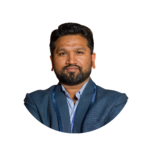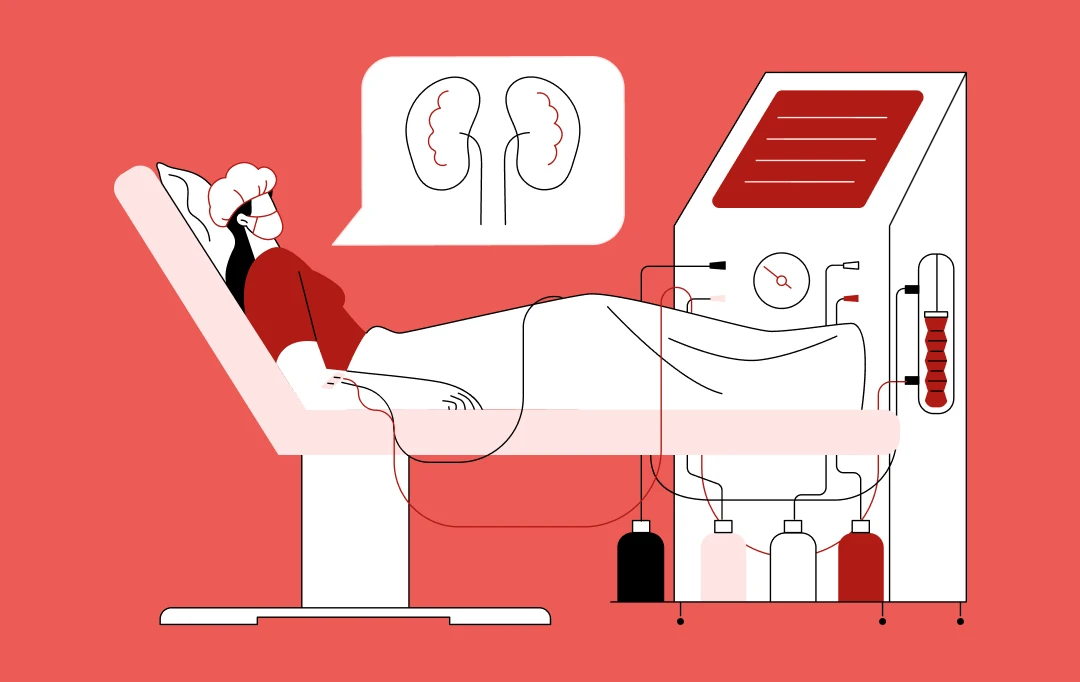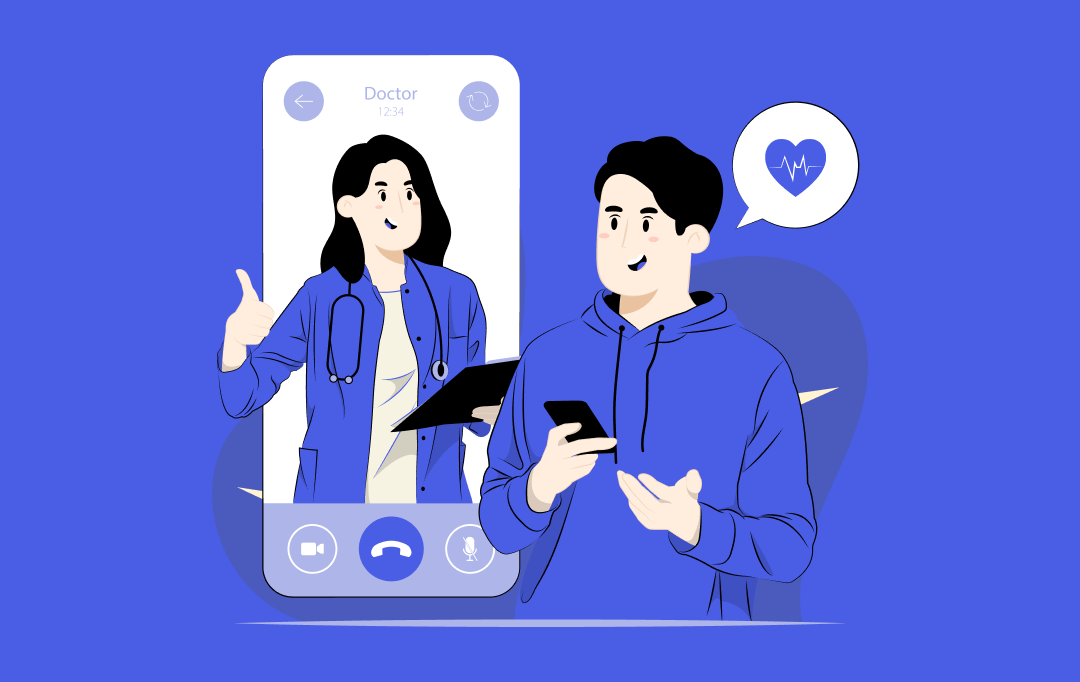- A Statistical Insight on the Future of Home Healthcare Technology
- What Does Home Healthcare Entail?
- An Overview of the Types of Home Healthcare Services
- Home Assistance
- Private Medical Assistance
- Medical Social Services
- Physical and Speech Therapy
- Technologies Impacting the Home Healthcare Ecosystem
- 1. Electronic Visit Verification
- 2. Remote Patient Monitoring Tools
- 3. Virtual Reality
- 4. Internet of Medical Things (IoMT)
- 5. Telehealth
- 6. Blockchain
- 7. Healthcare Chatbots
- 8. Electronic Health Records
- 9. GPS
- 10. Wearable Technology
- Exploring the Benefits of Home Healthcare Technology
- Chronic Illness Treatment
- Reduced Healthcare Costs
- Patient Engagement
- Decreased Readmissions
- Patient Safety
- Improved Quality of Life
- Challenges of Technology Integration in Home Healthcare and How to Overcome Them
- Poor User Experience
- Interoperability
- Asset Tracking
- Get Started on Your Journey to Home Health Technology With Appinventiv
- Winding Up
- FAQs
In the past, only a selected group of people had the luxury of receiving medical care in the convenience of their own homes. But in the modern era, as technology advances and becomes more widely available, home healthcare technology plays a more crucial role. This has ushered in a period rightly referred to as the digitalization of healthcare, impacting the healthcare industry while completely changing the way we live and work. Access to medical services has been made more convenient and inclusive through the democratization of healthcare by incorporating digital technology.
This blog entails an in-depth discussion on the impact of technology on home healthcare and how it is helping streamline medical processes and ensure improved patient care. We will also explore the challenges of implementing technological advances in home healthcare and the solutions to overcome them. However, let’s first understand the home health tech market. Let’s delve deeper.
A Statistical Insight on the Future of Home Healthcare Technology
As per Statista, the home healthcare market expenditure amounted to $113 billion in 2019 and is expected to reach a valuation of $173 billion by 2026. This remarkable growth highlights the increasing importance of home healthcare technology in meeting the evolving needs of patients and the healthcare industry.

Numerous important factors are responsible for this rapid increase. First off, the need for home healthcare is being supported by an aging population and an increase in disorders, including dementia, Alzheimer’s, and orthopedic ailments, that has significantly raised the demand for home healthcare technology solutions. 
What Does Home Healthcare Entail?
The provision of expert medical services in the comfort of your own home, whether needed temporarily or permanently, is covered by home care technology. Innovations in home healthcare not only provide services for elderly people or make senior care efficient, but they also provide services for people with different conditions like, individuals who have special needs or a disability, someone who is aging and needs help to live independently, people recovering from a medical setback, or suffering from chronic diseases, etc.
Patient care is being revolutionized by a plethora of home healthcare applications that offer quick fixes. From the comfort of their homes, patients can readily obtain medical assistance through direct phone conversations or online consultations with physicians. The efficiency of home healthcare providers is increasing with the transition from traditional paper-based records to healthcare digital systems. This change facilitates a smoother flow of patient data, enhances data accuracy, and streamlines information exchange.
As a result, medical professionals are able to provide patients with more accurate and timely care, which ultimately improves patient outcomes and the overall healthcare experience. Also, different types of apps for home healthcare services cater to a wide range of medical needs. Let’s have a look at those.
An Overview of the Types of Home Healthcare Services
Innovative home healthcare encompasses a wide range of medical and non-medical care provided to individuals in the comfort of their own homes. These services are designed to assist individuals recovering from an illness or surgery, managing a chronic condition, or simply needing assistance with daily activities. Let’s check them out:

Home Assistance
With medical assistance at home, professional caregivers can help people with activities like bathing, dressing, meal preparation, household tasks, and other daily activities. This helps individuals embrace independence and safety.
Private Medical Assistance
It allows individuals to get healthcare at home rather than in a medical facility. It involves medical experts like doctors and nurses to take care of people with chronic illnesses, special needs or disabilities, and medical injuries.
Medical Social Services
Medical social services offer a range of in-home medical support to patients, encompassing identification and counseling of community resources to aid in their recovery process. Certain medical social workers additionally function as the patient’s case manager when dealing with extremely complex medical conditions that call for coordinating with healthcare experts.
Physical and Speech Therapy
Some patients might require help relearning how to perform everyday tasks or work on their speech after a sickness or injury. A physical therapist can assemble an arrangement of care to assist a patient with recovering or reinforce the utilization of muscles and joints. A speech therapist can assist a patient with weakened speech in recovering the capacity to convey clearly.
With types of home healthcare technology being clearly defined, let’s move on to discuss the technological advances in home healthcare.
Technologies Impacting the Home Healthcare Ecosystem
The power of technology is revolutionizing home healthcare services. Medicines, equipment, and other healthcare requirements can be determined with the help of real-time technology.
The answer to “how is technology used in home healthcare” is mentioned below in points. But you should know that technological advances in home healthcare have reached a different level! Let’s discuss a few technologies that are reforming home healthcare.

1. Electronic Visit Verification
EVV, or electronic visit verification, is a technology that helps verify caregiver appointments, scheduling, and cancellations to avoid no-show home appointments. Hence, the service of home healthcare personnel is electronically verified. It mainly includes:
- The type of service requested by the individual
- Information about the patient
- Information of the home healthcare professional
- Location at which the service is required
- Date when the service is required
- The beginning and end times of the service
2. Remote Patient Monitoring Tools
Home health monitoring devices are the tools or devices that are used to track a patient’s well-being. In today’s world, we have fitness bands that keep a regular track of one’s activities like the number of steps walked, sleep and diet, etc. These innovative applications of wearable tech in healthcare assure individuals that someone is watching over them and tracking their every move toward a healthy and better lifestyle. These devices can also be connected to smartphones to reduce the cost and time spent visiting a doctor.
Many devices can also be used to measure blood pressure levels, glucose levels, heart rate monitoring, and other measurements. RPM allows caregivers, doctors, patients, and their families to track their healthcare needs and eliminate risks as well as regular doctor visits.
Healthcare professionals can remotely monitor patients’ vital signs and health information because of RPM technology. It makes early health issue diagnosis possible, which is beneficial for people who have long-term illnesses in particular. RPM makes healthcare more comfortable and accessible for patients by reducing the need for frequent in-person visits.
3. Virtual Reality
Virtual Reality (VR), as an advanced technology, is proving to be a game-changer for medical professionals and patients alike. By providing healthcare professionals with a realistic, low-risk environment, VR when combined with wearable technology, is transforming medical education. This novel strategy provides medical practitioners a significant opportunity to improve their competencies.
Virtual reality technology also expands its therapeutic potential to include mental and physical wellness. It plays a great role when it comes to healing and rehabilitation, especially during managing severe pain and treating anxiety problems. Virtual reality (VR) presents a potentially effective means of enhancing patients’ general health and quality of life by immersing them in virtual worlds.
4. Internet of Medical Things (IoMT)
Health information technology, medical services, devices, and data constitute the Internet of Medical Things or IoMT. A few advantages of IoMT for both medical professionals and patients are listed below:
- It reduces the room for mistakes
- The intake and effect of medicines can be monitored
- Digital therapy can be used to minimize pain, such as acupuncture, massages, etc
- Biofeedback systems can help caregivers track heart rate, temperature, glucose, blood pressure, etc.
5. Telehealth
Virtual home healthcare technology, like telehealth or telemedicine, allows consumers to get in touch with medical caregivers with the help of technology. By using mobile apps or video conferencing, doctors and nurses are just a finger touch away. Telemedicine allows patients to consult directly with medical professionals through video calls.
This technology saves time and money by greatly reducing the need for patients to visit healthcare centers physically. By bridging healthcare gaps, telehealth services provide access to specialists and consultations in underserved or rural areas.
Let’s discuss a few more benefits of medical technology:
- Telehealth is a great way for disabled and elderly patients to avoid traveling to and fro.
- It allows doctors to examine patients anywhere, anytime, and share the outcomes in real-time.
- It also makes the remote patient monitoring (RPM) process easier for medical professionals since they can check in on the patient in non-emergency situations as well.
6. Blockchain
It is said that blockchain will revolutionize the healthcare industry. Home health technology mainly depends on huge amounts of data from various resources. The data requires extensive analysis to gain crucial insights for the apt treatment required. Below are a few advantages of blockchain in healthcare:
- It can easily help verify and manage patient’s medical data
- Blockchain can be used for online payments and for the elimination of security issues
- The integration of blockchain and healthcare can also be used in clinical research and drug development
- It can be used to maintain data of trial patients, manage and keep track of documentation, and reduce falsification of results
7. Healthcare Chatbots
This AI-powered technology can be leveraged to provide automated interactions with patients during critical times. These AI-based healthcare chatbots, when integrated with medical information like symptoms, medications, treatments, medical conditions, doctor’s availability, etc, can be a time savior.
Among our noteworthy achievements in the healthcare sector is developing the in-hospital patient communications system known as YouCOMM. This intuitive interface includes voice commands and other manual options like head gestures, which enable patients to interact in real-time with nurses and other hospital staff.

YouCOMM has greatly increased communication effectiveness between patients and staff, enabling hospital management to keep detailed logs of how quickly patients receive their requests fulfilled. Given this solution’s success, more than five hospital chains in the US have adopted it, which has significantly increased nurses’ real-time response rates by 60%.
8. Electronic Health Records
Electronic Health Records or EHR systems offer safe and effective data access by managing and storing patient data electronically. EHRs make it easier for healthcare professionals to share data easily, which enhances care coordination. By allowing people to access their medical records, they also improve patient engagement.
Voice recognition technology allows doctors to enter patient data and information hands-free, which is a huge benefit for EHR systems. Dictating data in the EHR decreases inaccuracies and errors and expedites the process of capturing information.
9. GPS
In situations of crisis, for example, when senior and old age individuals are away from home for quite a while, GPS tracking can help their families, health workers, or law implementation bodies to find them rapidly. Features like mobile alarm services offer a hybrid approach, enabling the tracking of individuals, including the elderly, in locations or areas where GPS signals may be limited, like parking garages. These systems can also automatically initiate emergency calls for assistance when needed, making GPS an indispensable feature in emergency response services.
10. Wearable Technology
Innovative wearables hold great potential for revolutionizing home healthcare by providing patients with continuous monitoring and medical assistance in the convenience of their own homes. By incorporating AI with wearable technology, a committed medical professional can monitor patients’ vital signs and oversee their overall health, encouraging them to lead a healthy lifestyle.
Smartwatches and fitness trackers are examples of wearable technology that enables people to monitor an array of health data. These gadgets monitor heart rate, physical activity, sleep habits, and other health metrics, giving patients and medical professionals accurate information. Wearable technology gives people the ability to manage their health more actively.
Wearable in healthcare, in addition to improving patient care, drastically cut down on the time and expense involved in regular hospital visits. Innovative wearables are completely changing how we think about healthcare, making it more patient-centered, effective, and accessible.
Let’s now quickly look at the perks of home health technology.
Exploring the Benefits of Home Healthcare Technology
From telehealth platforms to remote monitoring devices, home healthcare technology solutions are gradually transforming how technology impacts healthcare. Let’s look at those:

Chronic Illness Treatment
Home healthcare technology helps people manage chronic diseases by providing various tools, such as online platforms and apps. In addition to tracking medicine consumption and monitoring their symptoms, patients can access helpful instructional materials. These remedies result in enhanced quality of life, better disease management, and less strain on healthcare organizations.
Reduced Healthcare Costs
The adoption of home healthcare technology lowers healthcare costs by lowering Emergency Room (ER) visits and hospital readmissions. Patients save money on travel and other costs, and healthcare systems gain from less crowding. Reduced costs help the healthcare industry allocate resources more effectively.
Patient Engagement
Mobile apps in healthcare have now enabled patients to actively participate, make better healthcare decisions, and lead a healthy lifestyle. In addition to tracking their health and interacting with their medical team, patients can access educational materials. Better outcomes and more informed healthcare decisions result from increased patient engagement.
Decreased Readmissions
Using home healthcare technology is essential to lowering the tendency of readmissions to the hospital. Patients can continue getting the care, monitoring, and rehabilitation they require in the comfort of their own homes after being released from the hospital.
This guarantees that patients receive the right treatment that can prevent complications, eventually minimizing the need for readmission to the hospital, and it also creates a more comfortable and stress-free rehabilitation environment.
Patient Safety
A range of devices and sensors used in home healthcare technology are intended to improve patient safety, especially for the elderly living alone. These gadgets can identify environmental dangers, including gas leaks or fires, falls, and abrupt changes in vital signs.
Alerts can be sent to family members or healthcare providers when a problem is found, guaranteeing quick support and action. This safety net lowers worry and the chance of mishaps at home while safeguarding patients and giving receiving patients and their loved ones peace of mind.
Improved Quality of Life
Home healthcare technology makes a big difference in people’s quality of life, especially for chronic illnesses or limited mobility. Greater comfort and independence are made possible by home care devices and services.
For instance, telemedicine and remote monitoring let patients remain in their comfortable surroundings by reducing the need for frequent clinic visits. Overall, patients’ lifestyles and general well-being are improved by home healthcare technologies.
Our experts at Appinventiv created a user-friendly, multi-dimensional healthcare platform called Health-e-People that not only streamlines healthcare record creation and management for medical caregivers but also delivers a user-centric solution that benefits patients, caregivers, and researchers alike, making it the top choice in the healthcare industry.

Health-e-people became the no.1 user-centric healthcare solution that benefitted both caregivers and patients.
Although innovative home healthcare has its own benefits, it is also filled with challenges and obstacles. Let’s check out the challenges of home healthcare technology solutions and ways to overcome them.
Challenges of Technology Integration in Home Healthcare and How to Overcome Them
On the one hand, technology has a positive impact on home healthcare services, but on the other hand, it also presents some unique challenges. Some of those issues with technology in home healthcare include:

Poor User Experience
While home health technology is constantly innovating, it is not of any significance if it is too difficult to use. Problems in the user interface, such as too much data and improper navigation, do not contribute to a good user experience.
Solution: This challenge can be knocked off by hiring the right team of healthcare developers who will make sure that the user interface is user-friendly and easy to navigate. They can even integrate a step-by-step navigation of the app to enhance the user experience.
Interoperability
Interoperability is the ability of a system to access, exchange, and integrate the data of a particular patient. This becomes a challenge when a patient’s information cannot be tracked with the right EHRs (Electronic Health Records).
Solution: Leveraging cloud computing in healthcare apps can overcome the challenge of interoperability. By implementing cloud-based Electronic Health Records (EHRs), not only is data security enhanced, but it also centralizes databases, facilitating easier access and management across various healthcare platforms.
Asset Tracking
The time-consuming nature of maintaining medical histories and health records, which can cause delays in workflow, is a common worry among healthcare providers.
Solution: Avoiding EHRs is not an option because of their crucial role in at-home treatment. Rather, the secret to ensuring this technology is used effectively and sparingly by caretakers is to provide them with appropriate training in its use. EHRs become a useful tool rather than a burden by providing healthcare workers with the required training and expertise, which streamlines the healthcare process and enhances patient care.
Get Started on Your Journey to Home Health Technology With Appinventiv
The delivery of healthcare is changing as it moves into residential settings. However, choosing the best healthcare app development company—one with experience in developing mobile apps and healthcare software is essential to achieving its full potential. This guarantees that the full potential of these technologies is realized.
It is critical that we start utilizing and realizing the perks of these healthcare technology advances if we are to maximize the advantages of medical technology for patients, doctors, nurses, and other healthcare professionals. It’s time for the new healthcare ecosystem to change, but are you ready to welcome it? Join hands with Appinventiv, your trusted healthcare mobile app development company, in your quest to realize the possibilities of home healthcare technology.
Winding Up
Healthcare at home is transforming the medical industry but it can be leveraged right if you hire a reliable healthcare app development company who masters in IT healthcare consulting and healthcare software development.
FAQs
Q. Mention some of the top uses of home healthcare.
A. To meet the demands of patients who need medical attention and support while still being comfortable in their homes, the innovations in home healthcare come with some uses. Among the principal applications of home healthcare are:
Chronic Disease Management: People with long-term medical issues like diabetes, high blood pressure, and heart disease can benefit greatly from home healthcare. To properly manage their diseases, patients receive education, medication management, and routine checkups.
Elderly Care: Seniors who have trouble traveling to hospitals can benefit most from home healthcare. It provides personalized healthcare services, help with everyday living, and medication management to enable older persons to get medical assistance in the comfort of their homes.
Post-Hospitalization Recovery: Many patients need ongoing care after being released, particularly following major surgeries or illnesses. During the healing process, home healthcare makes sure patients get the required medical treatment, rehabilitation, and supervision.
Pediatric Care: Patients with chronic illnesses, impairments, or complicated medical demands in children also require home healthcare, which is why it is so important for adults. It enables young patients to get support and specialized care in a setting they are accustomed to.
Telehealth and Remote Monitoring: Technology advancements have made telehealth and remote monitoring possible, enabling patients to consult virtually with medical specialists. In addition, devices can provide data, monitor vital signs, and notify healthcare providers of any alarming changes in a patient’s condition.
Q. How is technology transforming healthcare at home?
A. Technology is transforming healthcare at home by enabling remote patient monitoring, telemedicine, and the utilization of wearable devices. These innovations give medical personnel instant access to patient data, enabling prompt actions. With wearable technology, patients can track their health, consult with doctors via video conversations, and better manage chronic illnesses.
This change makes healthcare more easily accessible, convenient, and of higher quality overall, enabling people to obtain individualized treatment in the comfort of their own homes.
Q. What security measures are in place to guarantee patient privacy and security when using home healthcare technology?
A. To protect patient information in home healthcare technology, strong data security measures are used, such as encryption and stringent adherence to data protection laws.


- In just 2 mins you will get a response
- Your idea is 100% protected by our Non Disclosure Agreement.

Healthcare IT Outsourcing: Key Benefits, Best Practices, and Implementation Process
Key Takeaways Reduce Costs by 30-40%: Convert capital IT expenses to predictable operational costs, eliminating the need for large in-house teams and infrastructure. Focus on Core Patient Care: Free up internal resources from IT management to concentrate on core healthcare services, innovation, and growth. Ensure Compliance & Mitigate Risk: Leverage expert partners to navigate HIPAA…

How AI-Powered Virtual Health Assistants Are Enhancing Remote Patient Monitoring
Key takeaways: Remote patient monitoring has the potential to reduce hospital readmissions by up to a quarter, shifting healthcare from reactive to proactive care through continuous, real-time health tracking. The U.S. health intelligent virtual assistant market is expected to reach $1.87 billion by 2030, driven by the growing demand for continuous care, virtual consultations, and…

Why Telehealth Security is Non-Negotiable for Patient Trust and How to Achieve It
Key takeaways: Telehealth security is crucial for patient trust and the continued adoption of digital healthcare services. The rising tide of cyber threats, from ransomware to inadequate authentication, poses significant risks to patient data and provider reputation. Implementing robust security measures like end-to-end encryption, multi-factor authentication, and regular audits is non-negotiable. Compliance with regulations like…

















